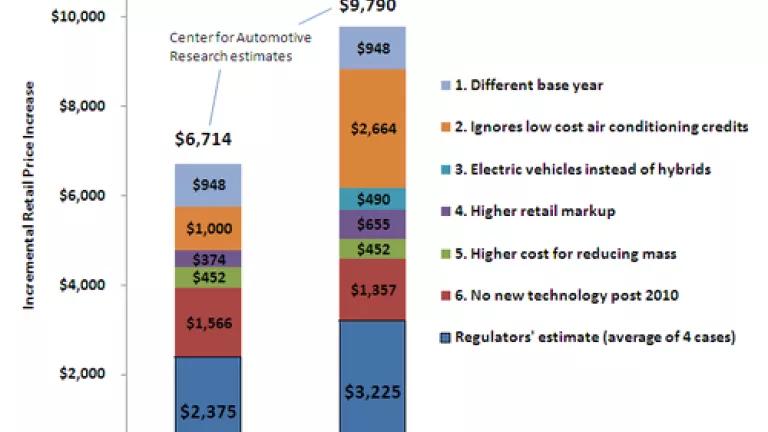
Last week the auto industry released their latest claims on the cost of stronger pollution and fuel economy standards by the Center for Automotive Research (CAR). According to this latest analysis, the costs of meeting a 62 mpg standards by 2025 will be $9,790. They also claim 260,000 jobs lost in 2025. But a close examination of the cost claims reveal they are inflated by a factor of three, and if the cost numbers are corrected, then CAR’s own model results in more, not less, jobs.
It's no surprise their estimate is almost exactly three times the $3,225 average cost forecasted by the U.S. Environmental Protection Agency (EPA), National Highway Safety and Traffic Administration and the California Air Resources Board. This latest auto industry cost claim falls in line with their historical pattern of exaggerating cost claims anywhere from 2 to 10 times. A close look at the CAR study reveals six key reasons why the auto industry and the agencies' cost estimates differ.
Reason #1: Different baselines. The CAR industry uses a baseline year of 2008 rather than the agencies’ baseline of 2016. Thus, the auto industry study includes the cost of the 2016 regulations of 34.1 mpg and 250 grams of CO2 per mile already on the books. Cost adjustment: $948 [Source: Final EPA and NHSTA GHG and CAFE rule for 2012-16]
Reason #2: Ignores low cost air conditioning credits. The CAR study primary scenario ignores low cost options to reduce air conditioning emissions. Instead it assumes automakers will choose higher cost technologies first. As a result, instead of roughly $100 worth of air conditioning credits that deliver the equivalent of 6 mpg benefits, the study assumes the auto industry will need more plug in hybrids at an average cost of $2,764 for the 62 mpg scenario. Net cost adjustment for 62 mpg: $2,664 [Source: NRDC estimate based on CAR study Appendix I and Final EPA and NHSTA GHG and CAFE rule for 2012-16]
Reason #3: Electric vehicles instead of hybrids. The CAR study assumes automakers will use higher cost plug in hybrid electric vehicles to comply, rather than relying on lower cost conventional hybrids. Assuming automakers meet the standard at lowest cost by using more hybrids and less plug-ins results in substantial savings. Net cost adjustment for 62 mpg: $490 [Source: NRDC estimate based on CAR 2011 study, and EPA and NHSTA technical assessment for 2017-25]
Reason #4: Higher retail markups on components. The CAR study relies upon an out of date assumption that the automakers can markup their costs 33 to 50 percent. In reality, the auto industry is very competitive and with less complex, mature technologies, the mark up is much less. The agencies have relied upon more detailed, in depth studies and developed technology-specific markups. Applying the agencies’ technology-specific markups to the auto industry scenarios, results in a 24 percent markup. Cost adjustment for 62 mpg: $655 [Source: NRDC estimate based on Final EPA and NHSTA GHG and CAFE rule for 2012-16]
Reason #5: Higher cost for mass reduction. Both studies estimate about a 10 percent reduction in mass. The CAR study however uses a cost estimate 60 percent higher than the agencies. The difference is that the agencies assume that with longer lead times, the automakers can more easily incorporate design changes. Indeed, we are already seeing automakers making this central part of their model redesigns. Net cost adjustment: $452 [Sources: NRDC estimate based on CAR 2011 study, and EPA and NHSTA technical assessment for 2017-25]
Reason #6: No new innovation past 2010. Finally, the CAR study inexplicably ignores any new technologies being introduced beyond 2010. It’s as if the cell industry said back in 1995 that the best you’ll have now is a Motorola Startac that cost $1000. The auto industry relies on a NAS study of very near-term technologies that did not assess the potential for new, lower cost hybrids (on the market now) and “cooled/boosted exhaust gas recirculation” that the agencies’ analysis shows is a viable, low cost option for 2025. Net cost adjustment: $1,357 [Source: NRDC estimate. See my blog here]
Bottom line: Cost overestimate of $6,569. By using a different baseline, ignoring low cost options and using out-of-date technology assumptions, the auto industry study systematically overestimates the cost of achieving a 62 mpg standard. The auto industry study cost estimate of nearly $10,000 is three times higher than what EPA and other agencies have estimated, exactly consistent with their historic pattern of exaggerating costs by 2 to 10 times.
Job claims exaggerated. Finally, it is critical to understand that the auto industry study result of 260,000 job lost in 2025 is entirely driven by their inflated cost estimates. The CAR study assumes that consumers value five years of fuel savings and if the fuel savings outweigh the incremental cost, sales (and jobs) will increase. The EPA and other agencies estimate a 62 mpg standard will pay back for itself in four years. Therefore, using the agencies’ cost assumption of $3,225 in CAR’s own job model yields exactly the opposite conclusion that what the auto industry is claiming: 62 mpg will result in more sales and more jobs.
